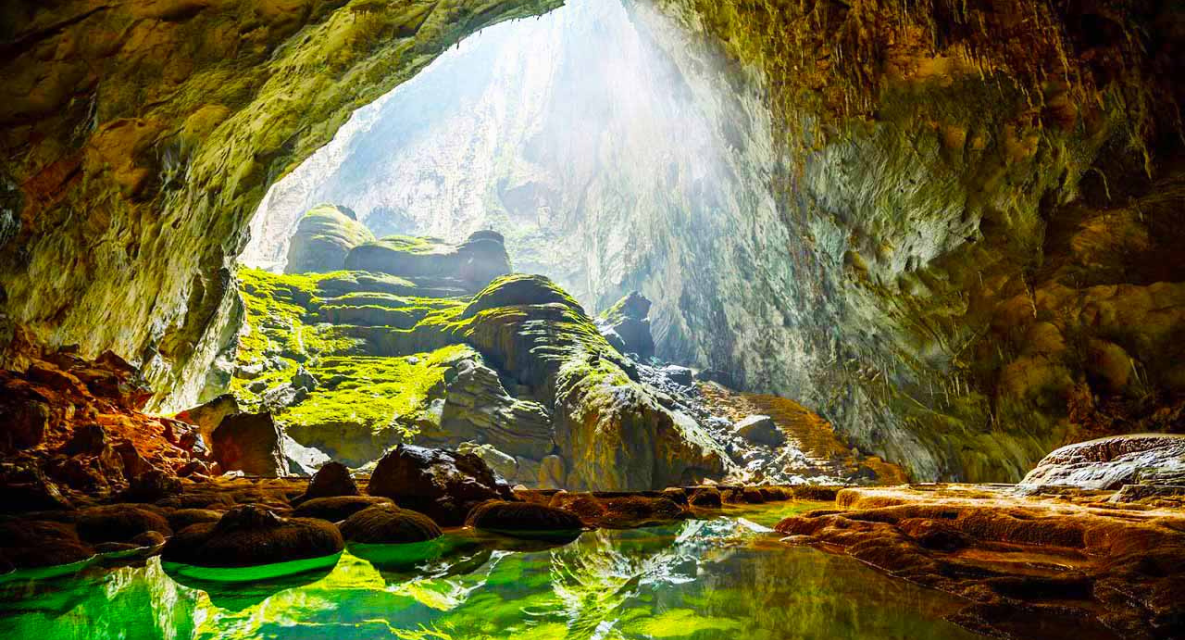Phong Nha Cave System
The Phong Nha Cave System is the longest cave system in Phong Nha – Ke Bang, with a length of over 100 km and comprising over 140 caves. Khe Ry Cave is the longest underground river cave in Asia, Hang En is one of the biggest caves in the world, and Son Doong Cave, also part of the Phong Nha Cave System, has the largest cave passage in the world. Son Doong Cave is located deep in the primary rainforest of Phong Nha – Ke Bang National Park, is over 9 km long, more than 150m wide and 200m high. Phong Nha Cave is the final cave in the system, where the water drains out to the Son River and then to the sea.

The outstanding caves in the Phong Nha system
Phong Nha Cave
Phong Nha Cave is a renowned natural wonder that boasts impressive geological and aesthetic values. It is an impressive river cave with a total length of 11 km. The British Vietnam Caving Expedition Team explored and surveyed the cave in 1990 and 1992, and captured stunning photographs, which were later featured in the International Caver magazine, introducing Phong Nha to a wider audience. Today, Phong Nha Cave is a popular tourist destination in Quang Binh, Vietnam. Tourists can take a boat trip along the Son River to reach the cave, where they can marvel at the stunning stalactites with unique formations.
Hang Son Doong – the largest cave in the world
Son Doong Cave is a part of the Phong Nha Cave System and the entrance was discovered in 1990. It was explored and surveyed in 2009. The cave runs along a large fault line in a north-south direction. It is estimated to have formed between 2 – 5 million years ago and is approximately 150 meters wide, over 200 meters tall, and nearly 9 kilometers long. Its estimated volume is 38.5 million cubic meters. With these dimensions, Son Doong Cave surpassed Deer Cave in Gunung Mulu National Park in Malaysia (100 meters tall, 90 meters wide, and 2 kilometers long) to become the largest natural cave in the world.
Inside Son Doong Cave, there is a section with a width of 91.44 meters and a ceiling height of almost 243.84 meters, which is large enough to fit a 40-story building. The cave has an underground river that is 2.5 kilometers long and features stalagmites as tall as 80 meters. It also has two “dolines” (collapsed sections of the ceiling that allow sunlight to enter) which are beneficial for the rainforest ecosystem thriving within the cave.
Hang En – one of the largest caves in the world
The British Vietnam Caving Expedition Team surveyed Hang En in 1994. At that time, it took the team three days to hike from Phong Nha to access the cave. Hang En is one of the most impressive caves in Vietnam, with a 200m wide, 145m high passage. The cave is 1.6km long and has some spectacular stalactite formations in the main passage. There is also a section of fault breccia (black and white rock) with several fractures, which is quite unusual.
The exit of the cave is 120m high and 110m wide. Thousands of Hang En birds live here and at sunset, the sight of the birds returning to the cave after a day of foraging is very impressive. Son Doong is about 2 km from the exit of Hang En. The stream flowing through Hang En enters a valley and joins with a stream from Hang Khe Ry, flowing into Son Doong. That is why Hang Khe Ry and Hang En are considered to be some of the main feeders of the Phong Nha Cave system.
Hang Va – a cave with unique stalactites
Among the surveyed caves, Hang Va is considered to have the most unique stalactites. Hang Va entrance was discovered in 1992 and was explored and surveyed in 2012. It is 1,686 meters long. Hang Va is particularly unique because it has a system of hundreds of uniformly sized stalactites. The stalactites are cone-shaped formations reaching heights of over 2 meters. The tower cones are located within enormous gour pools. It is not known exactly how these tower cone formations were created. One theory is that thin layers of calcite, also known as calcite rafts have built up on the surface of the pools. These thin layers float on the water surface until drops of water landing on them cause them to sink to the bottom of the pool. Over thousands of years, piles of rafts build up to form cones.
Hang Vom Cave System
The Vom Cave System is a system of around 70 explored caves with a total length of over 50 km and is also a significant river cave system in the Phong Nha – Ke Bàng limestone massif. This system starts with Ruc Ca Roong Cave located at an elevation of around 300 meters above sea level. After passing through many caves, the river resurges at Hang Vom, and flows into the Chay River, and then the Son River and finally the sea.
Nuoc Mooc Cave System
There are over 50 caves, with a total length of about 20 km. The Nuoc Mooc Cave System is quite mysterious because as yet the source of the underground stream has not been explored. The cave entrances are difficult to access. The highlight is the Mooc Stream, which wells up from this system, and the water body at the outlet is about 90 square meters. Most of the caves in this system are concentrated near the Mooc Stream and west of the Chay River in the center of the National Park.




